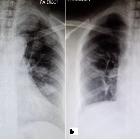Bronchiolitis obliterans with organising pneumonia (BOOP)













 nicht verwechseln mit: Bronchiolitis obliterans
nicht verwechseln mit: Bronchiolitis obliteransCryptogenic organizing pneumonia (COP) is a disease of unknown etiology characterized on imaging by multifocal ground glass opacifications and/or consolidation. A wide variety of infectious as well as noninfectious causes may result in a similar histologic pattern.
Terminology
Organizing pneumonia (OP) is a histological pattern of alveolar inflammation with varied etiology (including pulmonary infection). The idiopathic form of OP is called cryptogenic organizing pneumonia (COP) and it belongs to the idiopathic interstitial pneumonias (IIPs).
COP was previously termed bronchiolitis obliterans organizing pneumonia (BOOP), not to be confused with bronchiolitis obliterans .
Epidemiology
The presentation is commonest in the 55-60 years age group.
Clinical presentation
Patients present with a short history (i.e. less than ~2 months) of breathlessness, non-productive cough, weight loss, malaise and fever. There is no association with smoking.
Pathology
In addition to the alveolar inflammatory changes found with regular pneumonia, there is also the involvement of the bronchioles.
Histologically, it is characterized by mild chronic patchy interstitial inflammation without fibrosis and the presence of buds of granulation tissue made of mononuclear cells, foamy macrophages, and fibrous tissue (Masson bodies) in the distal airspaces which may cause secondary bronchiolar occlusion due to extension of the inflammatory process. Hence, the reason for being previously termed bronchiolitis obliterans organizing pneumonia (BOOP).
Radiographic features
Plain radiograph
- consolidation
- unilateral or bilateral patchy areas (commonest finding ): often migratory
- can affect all lung zones
- usually peripheral, subpleural, peribronchovascular
- nodules
- foci of granulation tissue up to 1 cm
- may mimic neoplasm if >5 cm in size
- may be numerous in immunocompromised patients
CT
The most common HRCT features include :
- patchy consolidation with a predominantly subpleural and/or peribronchial distribution
- small, ill-defined peribronchial or peribronchiolar nodules
- large nodules or masses
- bronchial wall thickening or dilatation in the abnormal lung regions
- a perilobular pattern with ill-defined linear opacities that are thicker than the thickened interlobular septa and have an arcade or polygonal appearance
- arcade-like sign of perilobular fibrosis describes an arch pattern in more than half of the patient with COP
- ground glass opacity or crazy paving
The reverse halo sign (atoll sign) is considered to be highly specific, although only seen in ~20% of patients with COP .
Treatment and prognosis
Corticosteroids have been widely used and most patients recover completely .
History and etymology
It was first described by Davison and colleagues in 1983.
Differential diagnosis
On a radiograph consider:
- differential for peripheral consolidation: reverse bat wing opacities
- differential for bilateral airspace opacities
On CT consider:
- adenocarcinoma in situ or minimally invasive (formerly bronchoalveolar carcinoma)
- pulmonary lymphoma
- pulmonary vasculitis/vasculitides
- sarcoidosis
- chronic eosinophilic pneumonia (for a subpleural consolidative pattern)
Siehe auch:
- Rheumatoide Arthritis
- Sarkoidose
- mosaikartige Verdichtungen der Lunge
- Bronchiolitis obliterans
- umgekehrtes Halozeichen Lunge
- Milchglasverschattungen
- Chronisch-entzündliche Darmerkrankungen
- In Situ Adenokarzinom der Lunge
- chronic eosinophilic pneumonia
- Bronchiolitis
- Lymphom pulmonale Manifestation
- pulmonale Vaskulitis
- obliterative bronchiolitis (mnemonic)
- acute fibrinous organizing pneumonia
- bilateral airspace opacities
- reverse bat wing opactities
und weiter:
- bronchial wall thickening
- Konsolidierung der Lunge
- reverse halo sign
- idiopathic interstitial pneumonia (mnemonic)
- Interstitielle Lungenerkrankung
- interstitial pneumonia
- pulmonale Manifestationen rheumatoide Arthritis
- differential of chronic alveolar opacities
- chronic bilateral airspace opacification
- What Every Radiologist Should Know about Idiopathic Interstitial Pneumonias
- crazy paving-Muster
- diffuse ground glass nodules
- Bleomycin induzierte Pneumonitis
- Carrington's disease
- peripheral lung opacities (mnemonic)
- organisierende Pneumonie
- medikamenteninduzierte Pneumonitis
- Löffler-Syndrom
- Idiopathische interstitielle Pneumonie

 Assoziationen und Differentialdiagnosen zu Kryptogene organisierende Pneumonie (COP):
Assoziationen und Differentialdiagnosen zu Kryptogene organisierende Pneumonie (COP):











